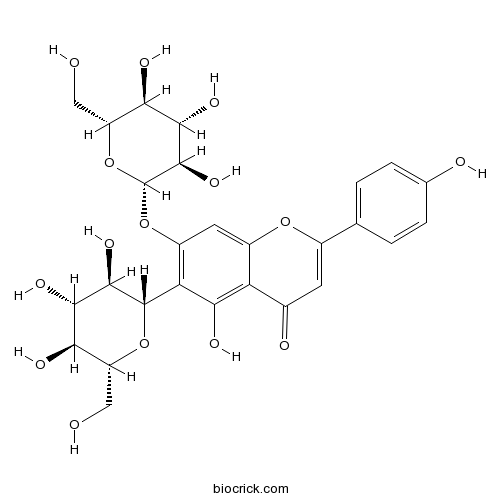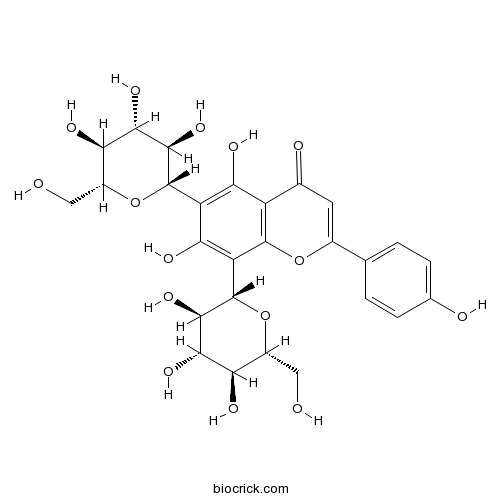Sophora davidii
Sophora davidii
1. The products in our compound library are selected from thousands of unique natural products; 2. It has the characteristics of diverse structure, diverse sources and wide coverage of activities; 3. Provide information on the activity of products from major journals, patents and research reports around the world, providing theoretical direction and research basis for further research and screening; 4. Free combination according to the type, source, target and disease of natural product; 5. The compound powder is placed in a covered tube and then discharged into a 10 x 10 cryostat; 6. Transport in ice pack or dry ice pack. Please store it at -20 °C as soon as possible after receiving the product, and use it as soon as possible after opening.
Natural products/compounds from Sophora davidii
- Cat.No. Product Name CAS Number COA
-
BCN2280
Saponarin20310-89-8
Instructions

-
BCN3013
Vicenin -223666-13-9
Instructions

-
BCN5156
Oxysophocarpine26904-64-3
Instructions

-
BCN2186
Vitamin D367-97-0
Instructions

-
BCN4237
Trifolirhizin6807-83-6
Instructions

-
BCN4249
Sophoridine6882-68-4
Instructions

Phylogeography of Sophora moorcroftiana Supports Wu's Hypothesis on the Origin of Tibetan Alpine Flora.[Pubmed: 28407107]
Wu hypothesized that the Tibetan flora originated mostly from the paleotropical Tertiary flora in the Hengduan Mountains by adapting to the cold and arid environments associated with the strong uplift of the Qinghai-Tibet Plateau (QTP). Here, we combine the phylogeographic history of Sophora moorcroftiana with that of Sophora davidii to explore the speciation of S. moorcroftiana to test this hypothesis. We collected 151 individuals from 17 populations and sequenced 2 chloroplast fragments and the internal transcribed spacer of rDNA. Five chlorotypes and 9 ribotypes were detected but no significant phylogeographic structure was revealed. The integrated results of phylogeographic studies of these 2 species clearly support the progenitor-derivative relationship between them. We infer that the western peripheral population of S. davidii migrated westwards from the Hengduan Mountains to the middle reaches of the Yarlung Zangbo River and differentiated from its ancestor in the process of adaptation to increasingly cold and arid environments with the uplift of the QTP and finally evolved into S. moorcroftiana during the Late Pliocene. In addition, our findings shed light on the idea that natural selection, as imposed by climate differentiation (especially mean diurnal range and precipitation seasonality), directly drove this peripatric speciation event after geographic isolation. The speciation of S. moorcroftiana is a strong case supporting Wu's hypothesis about the origin of Tibet's flora.
Phylogeography of Sophora davidii (Leguminosae) across the 'Tanaka-Kaiyong Line', an important phytogeographic boundary in Southwest China.[Pubmed: 23927411]
The 'Tanaka-Kaiyong Line' (TKL) is a major phytogeographic boundary in Southwest China, separating East Asia's Sino-Himalayan and Sino-Japanese Floras. However, little is known about the importance of this boundary in promoting intraspecific phylogeographic subdivision and divergence. Using chloroplast (cpDNA) and nuclear-intron (nDNA) sequence data, we reconstructed the population history of Sophora davidii, a drought-tolerant riparian shrub widely distributed on either side of the TKL. Specifically, we aimed at testing two long-standing explanations for possible vicariant events across the TKL: (i) Late Pliocene (c. 3 Ma) geological uplift of the eastern Qinghai-Tibetan Plateau (QTP) or (ii) a sharp environmental gradient associated with the establishment of different monsoon regimes on either side of the TKL during the (Late) Pleistocene. Our genealogical analyses detected a major west-east split in cpDNA, geographically largely consistent with the TKL, and dated to c. 1.28 Ma (95% HPD: 0.21-2.96 Ma), hence postdating the latest phase of eastern QTP uplift. Furthermore, integrating cpDNA phylogeographic patterns with mismatch analyses, we found multiple refugial isolation and long-term demographic stability of populations in the west (Hengduan Mountain Range) compared with extensive range expansions in the east, possibly during the last glacial period(s) and followed by differentiation into regional sublineages (southeast: Yunnan-Guizhou Plateau vs. northeast: Qinling Mts./Loess Plateau). Although nuclear differentiation was less marked, the geographical pattern of nDNA haplotypes provided some further indication of the species' eastward expansion, possibly from source populations located just east of the TKL (lower Jinshajiang region). Overall, the present data reject the geological (tectonic) explanation for the TKL and, instead, provide supportive evidence for its role as a climatically driven barrier to present-day plant dispersal. In addition, our study highlights changing temperatures and vegetation types during the last glacial period(s), along with aspects of regional topography, to be important determinants of the glacial eastward expansion of S. davidii. In consequence, our study lends support to a 'glacial out-of-Hengduan Mts'. hypothesis for the xerophytic-riparian flora of Southwest China, which in turn is inconsistent with the traditional view of the TKL as a 'classical' vicariant-biogeographic boundary.
[Effects of environmental stress on seedlings root growth and nodulation of leguminous shrubs in the dry valley of Minjiang River].[Pubmed: 19947198]
A field investigation was made to understand the seedlings root nodulation, biomass accumulation, root length, and fine root percentage of Sophora davidii, Indigofera lenticellata and Campylotropis polyantha along an altitudinal gradient on two contrasting sloped hills (north Zongqu and south Jingzhoushan) in the dry valley of Minjiang River. In the meantime, a greenhouse experiment was conducted to study the adaptation responses of 2 month-old S. davidii and C. polyantha seedlings root nodulation to different soil moisture regimes (80%, 60%, 40%, and 20% WHC). For the three test shrub species, fewer nodules were observed at lower altitude (1600-1950 m) areas, the nodule number per plant of S. davidii, I. lenticellata, and C. polyantha being 0.1 +/- 0.1, 0.9 +/- 0.5, and 5.7 +/- 1.9, and the non-nodulation plant accounting for 65.1%, 12.3% and 17.6%, respectively. The nodule number of the three species increased with increasing altitude, and correlated positively with root length and fine root percentage. However, there were no significant differences in the plant growth and biomass at different altitudes. When the soil moisture content was lower than 60% WHC, the nodule number and the fresh and dry mass of both S. davidii and C. polyantha decreased markedly, and at 20% WHC, no nodule and only 9.8 +/- 3.6 nodules were observed for S. davidii and C. polyantha, respectively, indicating that in this dry valley, the root nodulation capability of endemic leguminous shrubs was very low. Comparing with S. davidii, C. polyantha had higher root nodulation capability and drought-resistance. Prior to introducing these shrub species in forestation practices, to keep the soil moisture content higher than 40% WHC was recommended for relatively efficient biological nitrogen fixation.
[Study on pharmacognosy of Sophora davidii].[Pubmed: 18589743]
The primary microscopic observation of several parts of Sophora davidii (Franch.) Pav. such as crude drug, fabric, powder characteristic was carried out, and the microstructure and powder characteristic pictures was drawn, in order to provide scientific references for its further research and comprehensive exploration of the resource.
[Dynamics of Sophora davidii population in a hilly region closed for thirty years in Loess Plateau].[Pubmed: 16706034]
Taking wild grass ground as the reference, this paper studied the dynamics of Sophora davidii population on the sunny, semi-sunny and semi-shady slopes of hilly region in Loess Plateau after 30 years closed for reforestation, and analyzed the age structure, spatial distribution pattern, life table, and survival curve of the population. The results showed that S. dvidii population in the region belonged to progressive type, with more young and less old individuals. Among the three habits, semi-sunny slope had the highest population density. The survival curve of S. dvidii population was approached to Deevey 11 type. The population pattern was of clustered distribution, with the aggregating intensity increased with age. Water and light were the main environmental factors affecting the recovery and development of S. davidii community. The better recovery of S. davidii population suggested that the measures of closing the land for reforestation were efficient.
[Eco-anatomical characteristics of Sophora davidii leaves along an elevation gradient in upper Minjiang River dry valley].[Pubmed: 16689224]
This paper studied the eco-anatomical characteristics of Sorphora davidii leaves at the elevations of 1,650, 1,750, 1,850 and 1,950 m in the upper reaches of Minjiang River dry valley. The indices investigated were leaf length (LL), leaf width (LW), LL/ LW, leaf area, leaf thickness, leaf epidermal thickness, leaf palisade mesophyll thickness (P), leaf spongy mesophyll thickness (S), P/S, leaf cutin membrane thickness, leaf stomatal density and area, leaf epidermis cell density and area, and leaf pubescence length and density. The results showed that the leaves of S. davidii were elliptic, with an area 0.144 approximately 0.208 cm2 and a thickness 171.58 approximately 195.83 microm. The mesophyll was significantly differentiated into palisade and spongy. The thickness of palisade mesophyll was 69.83 approximately 82.42 microm, that of spongy mesophyll was 62.00 approximately 80.67 microm, and P/S was 1.14 approximately 1.01. Upper epidermal thickness was 14.03 approximately 15.33 microm, while lower epidermal thickness was 13.88 approximately 16.17 microm. The stomatal density, stomatal area, epidermis cell density, epidermis cell area, pubescence length, and pubescence density were 13.71 approximately 15.02 mm(-2), 249.86 approximately 280.43 microm2, 160.54 approximately 178.43 mm(-2), 557.43 approximately 626.85 microm2, 186.51 approximately 260.99 microm, and 18.29 approximately 32.27 mm(-2), respectively. With increasing elevation, the leaf area, leaf thickness, palisade mesophyll thickness, spongy mesophyll thickness, stomatal area, epidermis cell area and pubescence density were increased, while cutin membrane thickness, epidermis cell density, pubescence length, and stomatal density were decreased. There was no significant difference in LL/LW, P/S, epidermal thickness and stomatal density along the elevation gradient.
[Niche characteristics of dominant populations of Sophora davidii community in loess gully region].[Pubmed: 16515163]
Based on field investigation data and employing Levin and niche proportional similarity formulae, this paper calculated the niche breadth, niche proportional similarity, and niche overlap of 13 dominant species of Sophora davidii community in loess gully region. The results showed that the niche breadth of the dominant populations of Sophora davidii community decreased in order of Sophora davidii (0.964), Artemisia giraldii (0.775), Arteniisia gmelinii (0.664), Thenmeda triandra var. japonica (0.508), Polygala tenuifolia (0.485), Setaria viridis (0.399), Cynodon dactylon (0.393), Bothriochloa ischaemum (0.327), Lespedeza davurica (0.321), Stipa bungeana (0.472), Periploca sepium (0.292), Clemnatis fruticosa (0.251), and Cleistogenes squarrosa (0.234). The niche proportional similarity between Sophora davidii and other species was 0.21-0.76, while the niche overlap was not high, which meant that there was no severe competition between them. It could be concluded that Sophora davidii was the dominant population in the community, with most resources utilization and most adaptability to the ecosystem.
Stilbene oligomers in roots of Sophora davidii.[Pubmed: 10820822]
Three stilbene oligomers, davidiols A-C were isolated from the roots of Sophora davidii in addition to the seven known phenols, leachianone A, sophoraflavanones G, H and I, miyabenol C, alpha-viniferin and epsilon-viniferin. Their structures and relative configurations were established by means of 2D-NMR spectroscopy including COLOC and PSNOESY.


